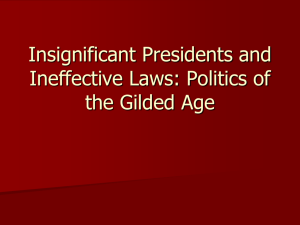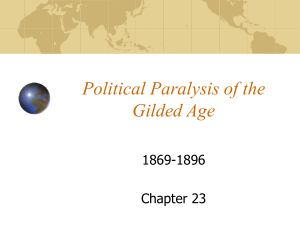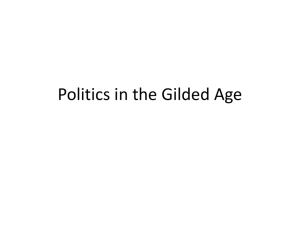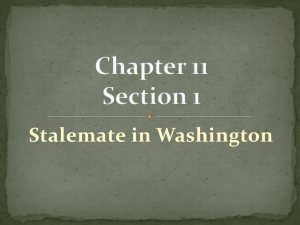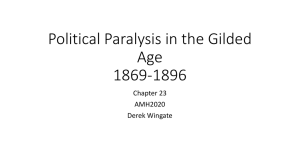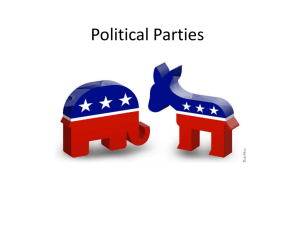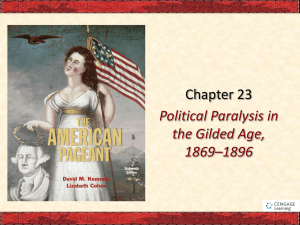Gilded Age - Marshall Public Schools
advertisement
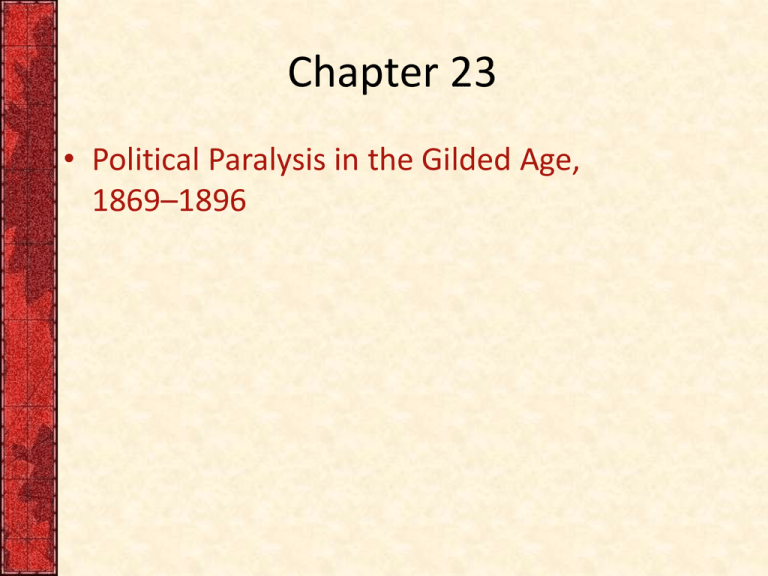
Chapter 23 • Political Paralysis in the Gilded Age, 1869–1896 I. The “Bloody Shirt” Elects Grant • Republicans called for a continued Reconstruction of the South using the bayonet if need be. • They made Grant their nominee and called for people to “Vote as you shot.” – Aimed at Union army veterans. • Grant won 214 electoral votes to Horatio Seymour’s 80, however, Grant only won the popular vote by 300,000 votes (3,013,421 to 2,706,829). II. The Era of Good Stealings • Corruption was rampant during Grant’s administration. A great example was the Tweed Ring in New York City. – “Boss” Tweed used bribery, graft, and fraudulent elections to milk the city of at least $200 million. • He was finally brought down in large part by a New York Times cartoonist named Thomas Nast. Tweed had complained that his illiterate followers couldn’t help but see “them damn pictures.” p490 III. A Carnival of Corruption • Grant’s own cabinet proved to be just as bad as the rest. – The first major scandal to hit Grant was the Credit Mobilier scandal in 1872. Union Pacific Railroad insiders formed the Credit Mobilier construction company and then hired themselves at inflated prices to build the railroad line earning returns over 300%. • When they thought the whistle was going to be blown they distributed shares of stock to key congressmen. – A congressional investigation showed not only congressmen involved, but the vice president as well. – The second scandal was the Whiskey Ring scandal between 1874-1875. • The Whiskey Ring robbed the Treasury of millions in excise-tax revenues. Even though Grant said, “let no guilty man escape,” he wrote up a statement to the jury that helped free his own private secretary. V. Depression, Deflation, and Inflation • The Panic of 1873 – leading up to 1873 there was a period of major capitalist expansion. Promoters were laying too much railroad track, digging too many mines, erecting too many factories and planting too much grain for the economy to handle. Eventually, these bubbles burst into a full blown depression. – Inflation or Deflation?? • Some wanted inflationary policies by issuing greenbacks… they reasoned that more money meant cheaper money, and with that, a rise in prices (of whatever they sold) making it easier to pay their debts. • Some wanted deflation, they were known as “hardmoney” advocates. Their policy was a reduction of greenbacks… they had no desire to see the money they loaned repaid in depreciated dollars. VI. Pallid Politics in the Gilded Age • Gilded Age – a term that meant beautiful on the outside but cheap on the inside. Given by Mark Twain in reference to all the corruption of the era. • During this time, political loyalty was very strict with straight ticket voting as the norm. • This was in large part because of the sharp ethnic and cultural differences. – Republicans tended to come from Puritan backgrounds. They stressed morality and believed the government should play a role in regulating both the economic and moral affairs of society. – Democrats many of which were immigrant Lutherans and Roman Catholics took a less stern view of morality. They hated the idea of having the government impose a one size fits all moral standard on society. • Patronage – Party leaders would disburse jobs in return for votes. p493 p493 VII. The Hayes-Tilden Standoff, 1876 • Republicans thought better than having Grant run for a third term so they nominated Rutherford B. Hayes as their candidate. • Democrats nominated Samuel Tilden, the one who had taken down “Boss” Tweed, as their candidate. • Tilden received 184 electoral votes (1 shy of the required 185) with some Southern states holding irregular returns. These return numbers weren’t official until every state submitted their final counts. – Each state in question produced two sets of return numbers, one republican and one democrat. – The question was who would decide which to count, because whoever decided would pretty much be deciding who would win - Republican or Democrat. Map 23-1 p494 VIII. The Compromise of 1877 and the End of Reconstruction • The Compromise of 1877 – – The electoral deadlock would be legally broken by an electoral commission of 15 men selected from the Senate, House, and the Supreme Court. – When the first state in question went to the commission for a vote, the results were a partisan 8 to 7 in favor of the Republicans. • The democrats were furious. • They decided to play ball. If Hayes was going to win they were going to get as much as possible in return. • The first thing Democrats wanted was the removal of Federal troops from the last two states in the South, Louisiana and South Carolina. • Republicans also promised a little patronage for Democrats and some subsidies for Texas and a Southern transcontinental railroad. Note: the last two never happened. • As President Hayes withdrew the Federal troops he also withdrew the idea of a bayonet-backed reconstruction… Reconstruction ends, 1877. p495 IX. The Birth of Jim Crow in the Post-Reconstruction South • Many blacks were forced into sharecropping and tenant farming. Their landlords and creditors were often old slave masters. • The “Crop-lien” system was how merchants extended credit to farmers for food and supplies. This system was often manipulated to favor the merchant and hold the farmer under his thumb for years to come. • Jim Crow laws started as an informal segragation of blacks and whites, but by the 1890’s turned into a systematic set of legal codes. • Plessy v. Ferguson – (1896) ruled for “separate but equal” facilities. – Schools, railroad cars, theaters, bathrooms, etc. – To maintain the codes, southern whites punished any black who dared violate the racial code of conduct. • A record number of blacks were lynched in the 1890’s. p496 Table 23-2 p497 X. Class Conflicts and Ethnic Clashes • Chinese immigrants had originally come to America for the Gold rush or to build the transcontinental railroad, but as gold ran out and the tracks were laid, times got pretty tough for the Chinese. – They were forced to work menial jobs: • Cooks, laundrymen, domestic servants, etc. – White men resented the Chinese cheap labor which led to Chinese men being terrorized. • Chinese Exclusion Act – (1882) prohibited further Chinese immigration until 1943. p498 XI. Garfield and Arthur • “Halfbreeds” and “Stalwarts” – – “Stalwarts” (Chester A. Arthur) supported patronage/spoils system – “Halfbreeds” (James Garfield) hated patronage/spoils system • Pendleton Act (1883) – – made compulsory campaign contributions from federal employees illegal – Established competitive examinations for accepting Federal jobs. XII. The Blaine-Cleveland Mudslingers of 1884 • James G. Blaine was nominated the Republican presidential candidate for the 1884 election. – He turned many away (especially reformers) from the Republican brand with his reputation for corruption. • Republicans called those who left “mugwumps” which is an algonquian word for “holier-than-thou.” • Grover Cleveland had been nominated by the Democrats. – He began as a powerful reformer and honest man (known as “Grover the Good”), but scandal soon caught up with him. • Republicans dug up the fact that he had an affair with a widow during his past, and that he had provided financially for the 8 year old boy of the widow… hence, the “I Want My Pa!” cartoon. p502 XIII. “Old Grover” Takes Over • After 24 years the Democrats finally took the White House. • Cleveland was a man of principles (most of the time) and a strict supporter of Laissez-faire. – He vetoed a bill that would help Texans that were hurt by a severe drought. His statement was, “though the people support the government, the government should not support the people.” XIV. Cleveland Battles for a Lower Tariff • During the Civil War tariff rates had been jacked up, which protected industrialists but raised the price of consumer goods. • Cleveland, being a believer in small government was embarrassed to see the annual federal surplus over $145 million. • He decided to lower tariffs. – This provided the first real division between the Dem’s. and Repub’s. leading up to the 1888 election. • Republicans turned to Benjamin Harrison who Believed in High tariff rates. • Democrats stayed with Grover CLeveLand who Liked the Lower tariff rates. • Harrison inched out Cleveland by a nose. XV. The Billion-Dollar Congress • The first congress to appropriate on Billion dollars. – They kept the tariff rates high and actually boosted rates to 48% on dutiable goods by passing the McKinley Tariff Act of 1890. • Farmers were hit hardest. They were forced to pay high prices for consumer goods while selling their crops in very competitive markets. XVI. The Drumbeat of Discontent • 1892 brought the People’s Party or “Populists” on the scene. – They demanded inflation through free and unlimited coinage of silver at the rate of 16 ounces of silver to 1 ounce gold. (creating more currency will produce inflation) – They also called for: • A graduated income tax, gov’t ownership of railroads, telegraph and telephone; direct election of U.S. senators, one-term limit for presidency, referendums allowing citizens to shape legislation, shorter workday, and immigration restrictions. p506 • During the summer of 1892, upset workers and indebted farmers joined together to fight the capitalist order. – The Homestead Strike • Andrew Carnegie’s Homestead steel plant armed 300 Pinkerton detectives to crush the strike by angry steelworkers. • The steelworkers, armed with rifles and dynamite, beat back the detectives after a battle that left 10 dead and 60 wounded. • Troops were then brought in and the strike was put down. p506 • During the 1892 presidential election white farmers tried to enlist black farmers to vote for the Populist cause. – As some blacks mobilized, southern whites aggressively went after limiting black suffrage via literacy tests and poll taxes. • The grandfather clause exempted anyone whose father or grandfather had voted in the 1860 election. Map 23-3 p507 XVII. Cleveland and Depression • Just as Cleveland began his nonconsecutive term, he faced the devastating depression of 1893. – It lasted for about 4 years. Contributing cause were: • Overbuilding and speculation • Labor disorders • The ongoing agrarian depression – Cleveland’s hands off approach left any relief for the masses to come from the feeble resources of charities. • The debate over the repeal of the silver act heated up in Congress. – A 33 year old Williams Jennings Bryan championed the cause of free silver. • They wanted to add silver to the money supply to create inflation. • Gold was also in very short supply and they didn’t want to go off the gold standard. – J.P. Morgan ended up lending the gov’t about 65 million in gold. A temporary fix. XVIII. Cleveland Breeds a Backlash • Cleveland gets called a sellout for taking the loan from Morgan. He was called “Morgan’s errand boy”.

